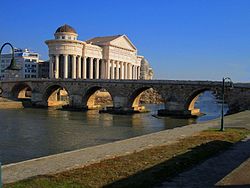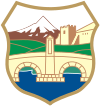Stone Bridge (Skopje)
Stone Bridge Камен Мост (Macedonian) | |
|---|---|
 | |
| Coordinates | 41°59′49″N 21°25′59″E / 41.996992°N 21.433071°E |
| Crosses | Vardar River |
| Locale | Skopje, North Macedonia |
| Characteristics | |
| Design | arch bridge |
| Total length | 214 m |
| Width | 6 m |
| History | |
| Construction start | 1451 |
| Construction end | 1469 |
| Location | |
 | |
The Stone Bridge (
The bridge is considered a symbol of Skopje and is the main element of the
Architecture

The Stone Bridge is built of solid stone blocks and is supported by firm columns that are connected with 12 semicircular arcs. The bridge is 214 m (702 ft) long and 6 m (20 ft) wide. The guardhouse has recently been reconstructed.[5]
History
The current Stone Bridge was built on Roman foundations under the patronage of Sultan
Serbia acquired new territory in Macedonia after the
By the German retreat from the city in November 1944, explosives were placed on the bridge by Nazis. Upon a request from city notables, the Germans gave up at the last minute and the bridge was saved from destruction. The last reconstruction of the bridge began in 1994. Over seven years during the Stone Bridge refurbishment of the 1990s, people were not allowed to cross the structure and for many craftsmen from the nearby Old Bazaar it resulted in negative economic effects.[11] The watchtower shaped like a mihrab was reconstructed in 2008.
Two parts of Skopje that have symbolised its urban contrasts of "Ottoman" or "modern", the "historic" or "socialist", "Albanian" or "Macedonian" are split by the river Vardar and linked by the Stone Bridge.[9] In the twenty first century, members of the majority and minority groups of the capital city view the stone bridge as representing the split between two parts of Skopje.[9]
Gallery
-
Stone Bridge andMacedonia Squarein the early 1920s
-
Stone Bridge in 1909
-
Inscription on the bridge
-
Stone Bridge at night
-
Memorial plaque on the site of Karposh's execution
-
View from the top
-
Lateral view
-
Stone Bridge, photo from the 1950s
-
A view of Stone Bridge and the Square
See also
References
- ^ Knowledge Bank at OSU
- ^ Official portal of the city of Skopje: City symbols. Retrieved 13 May 2009.
- ^ Ragaru 2008, p. 553.
- ^ Stone bridge, Skopje, Macedonia. Archived 2011-05-26 at the Wayback Machine
- ^ Kameniot Most na Vardar, Skopje
- ISBN 1841622974, p. 139.
- ^ Skopje In Your Pocket 2006-2007, Sco, Jeroen van Marle, In Your Pocket, p. 27.
- ^ Macedonia, Jovan Popovski, Turistička štampa, 1969, p. 66.
- ^ a b c Ragaru 2008, p. 536.
- ^ Clark, Christopher (2012). The Sleepwalkers: How Europe Went to War in 1914, pg.44
- ^ Ragaru, Nadege (2008). "The Political Uses and Social Lives of "National Heroes": Controversies over Skanderbeg's Statue in Skopje". Südosteuropa. 56 (4): 554.










